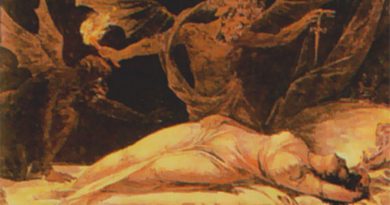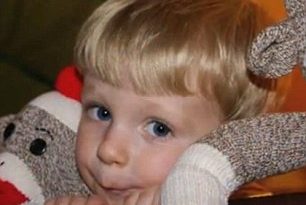Mysteries of SkinWalkers
In some Native American traditions (Navajo, Hopi, Mohawk…) the skin-walker or yeenaaldlooshii is a human who is able to shapeshift into various animal forms through witchcraft. Skin-walkers are generally considered frightening, evil, dangerous, and difficult to kill.Yeenaeldooshi means literally “with it, he goes on all fours” in the Navajo language. The Mohawk Indian word “limikkin” is sometimes used to describe all skin-walkers.
Possibly the best documented skinwalker beliefs are those relating to the Navajo yee naaldlooshii (literally “with it, he goes on all fours” in the Navajo language). A yee naaldlooshii is one of several varieties of Navajo witch (specifically practitioner of the Witchery Way, as opposed to a user of curse-objects or a practitioner of Frenzy Way . Technically, the term refers to who is using his (rarely her) powers to travel in animal form. In some versions men or women who have attained the highest level of priesthood then commit the act of killing an immediate member of their family, and then have thus gained the evil powers that are associated with skinwalkers.
The Yeenaeldooshi are human beings who have gained supernatural power by breaking a cultural taboo. Specifically, a person is said to gain the power to become a yee naaldlooshii upon initiation into the Witchery Way. Both men and women can become Yeenaeldooshi and therefore possibly skinwalkers, but men are far more numerous. It is generally thought that only childless women can become witches.
Although it is most frequently seen as a coyote, wolf, owl, fox, or crow, the yee naaldlooshii is said to have the power to assume the form of any animal they choose, depending on what kind of abilities they need. Witches use the form for expedient travel, especially to the Navajo equivalent of the ‘Black Mass’, a perverted song (and the central rite of the Witchery Way) used to curse instead of to heal. They also may transform to escape from pursuers.
Description/Morphology
A skinwalker is usually described as naked, except for a coyote skin, or wolf skin. Some Navajos describe them as a mutated version of the animal in question. The skin may just be a mask, like those which are the only garment worn in the witches’ sing. The skinwalkers are described as being fast, agile, and impossible to catch. Though some attempts have been made to shoot or kill one, they are not usually successful.
Behavior
Skin-walkers sometimes transform themselves into animals simply for the purpose of traversing great distances quickly. They may also transform in order to wreak havoc on others, as their identity will be hidden and they will be able to escape quickly if necessary.
A skin-walker typically wears the pelt of the animal he or she will transform into, usually with no other clothing. Because of their association with skin-walkers, wild animal hides are taboo in Navajo culture and rarely seen.
Powers/Weaknesses
- Like the werewolf, the skin-walker is a shape-shifter, human at times, and at other times taking on the aspect of an animal, usually at night. In its animal form, a skin-walker may be virtually anything, including a wolf, coyote, fox, bear, owl, or crow. Although skin-walkers may have a favorite form that they customarily use, they have the power to become anything they wish. In animal form, a skin-walker is very fast and impossible to catch.
- According to Navajo legend, skinwalkers can have the power to read human thoughts. They also possess the ability to make any human or animal noise they choose. A skinwalker may use the voice of a relative or the cry of an infant to lure victims out of the safety of their homes.
- Both humans and animals can easily tell a skin-walker from a real animal, as the skin-walker is unable to move completely naturally in animal form. For some unexplainable reason even a well seasoned skinwalker cannot obtain the perfect animal gait or leave the proportionally correct sized animal tracks.
- A skin-walker can only be defeated if one can discover his or her human identity. This is possible if the skin-walker is tracked back to his or her home, or, in some stories, if a skin-walker is wounded and the same injury is later noted on a human. It is said that if a Navajo was to know the person behind the skinwalker they had to pronounce the full name by saying, “[Name], you are a skin-walker !”. And about three days later that person would either get sick or die for the wrong that they have committed.
- While it is virtually impossible to kill a skin-walker in human form, there are magical ways to protect oneself and even to kill a skin-walker. Traditional faith healers can perform ceremonies to protect one from the danger of skin-walkers, or a person going out at night can cover his or her body with corn pollen, cedar ash, or juniper berries. ” If a person discovers the human identity of a skin-walker, he or she can kill the witch
Beliefs
Similar creatures can be found in numerous cultures’ lores all over the world, closely related to beliefs in werewolves (also known as lycanthropes) and other “were” creatures (which can be described as therianthropes). While the skin-walker is known mainly from Navajo folklore, analogies exist in the mythology of other tribes, including the Mohawk, Hopi, and Aztecs. The Yaqui have a similar creature they call Morea-kame. this is a person who practices witchcraft or what we might ball black magic. These creatures also change shape, appearing as animals or even as ghosts. They kill using their thoughts or the evil eye.
Navajo tradition
- A Yeenaaldlooshii is one of several varieties of Navajo witch (specifically an ántiihnii or practitioner of the Witchery Way, as opposed to a user of curse-objects (adagash) or a practitioner of Frenzy Way (azhitee)). Technically, the term refers to an ántiihnii who is using his (rarely her) powers to travel in animal form. The ántiihnii are human beings who have gained supernatural power by breaking a cultural taboo. Specifically, a person is said to gain the power to become a Yeenaaldlooshii upon initiation into the Witchery Way. Both men and women can become ántiihnii and therefore possibly skinwalkers, but men are far more numerous. It is generally thought that only childless women can become witches.
- Yenaldlooshi gain power by killing a close relative, sometimes even a sibling. They are known to desecrate sand paintings by urinating, spitting, & defecating on them. They also practice cannibalism and necrophilia. Yenaldlooshi are also said to be able to create a pollen from ground human infant bones that when sprinkled on sleeping Navajo families, causes sickness, social problems, & death.
- Although it is most frequently seen as a coyote, wolf, owl, fox, or crow, the Yeenaaldlooshii is said to have the power to assume the form of any animal they choose, depending on what kind of abilities they need. Witches use the form for expedient travel, especially to the Navajo equivalent of the ‘Black Mass’, a perverted sing (and the central rite of the Witchery Way) used to curse instead of to heal. They also may transform to escape from pursuers.
- Some Navajo also believe that skinwalkers have the ability to steal the “skin” or body of a person. The Navajo believe that if you lock eyes with a skinwalker they can absorb themselves into your body. It is also said that skinwalkers avoid the light and that their eyes glow like an animal’s when in human form and when in animal form their eyes do not glow as an animal’s would.
- Because animal skins are used primarily by skinwalkers, the pelt of animals such as bears, coyotes, wolves, and cougars are strictly tabooed. Sheepskin and buckskin are probably two of the few hides used by Navajos, the latter is used only for ceremonial purposes.
- Some tribes believe that skinwalkers can use the spit, hair, or shoes and old clothing of a person to make curses that will attack that specific person. For this reason many Navajo will never spit or leave shoes outside. They also take great care to see that any hair or nail clippings are burned.
Hopi tradition
In ancient Hopi culture there was a ritual ceremony once performed called the Ya Ya Ceremony. In this ceremony members would change themselves into various animals using the hide from the animal they chose, and the members use certain animal attributes like sight, strength,etc. The ceremony was banned after members developed a disease of the eyes.
Norse beliefs
- In Norse folklore, a skin-walker is a person who can travel in the shape of an animal and learn secrets, or take on certain characteristics of an animal. The person is then said to be wearing that animal’s hide. The most well-known example of the latter is the warrior who takes on the strength and stamina of a bear, called “bear shirt” or ber sarkur, the origins of the word berserker; similarly, there were wolf-based warriors, called ulfheðnar or “wolf-coats”. They were said, aside from the battle-rage the animal spirit granted, to have the ability to send out their soul in the form of their animal, in a practice called hamfarir or “shape-journey”.
- According to Mythology, the Norse hero Sigmund and his son Sinfiolti became Skinwalkers for a short time, discovering two magic wolf skins that turned them into wolves when they put them on. When they became overcome by their animal instincts and began fighting over meat, Sigmund almost killed his son and so they decided to burn the skins.
- The use of an animal shape for other purposes was considered unholy, and people accused of having such abilities were frequently cast out or summarily executed. Females so charged got off more lightly.
In January 1970, a hairy man about 5 feet 7 inches tall kept pace with a car driven by four youths near Whitewater, New Mexico. They increased the speed from 45 to 60 miles per hour, but it still kept up. Finally, one of them shot it, and it fell down.
In the fall of 1973 western Pennsylvania played host to dozens of reports of strange apelike creatures, sometimes seen in association with UFOs, said to have (in one witness’s words) “fire red eyes that glowed in total darkness,” to be seven to eight feet tall, and to give off a strong, unpleasant odor. “Another type of creature,” investigator Stan Gordon noted, “was said to be between five and six feet tall. It was described as looking just like an extremely muscular man with a covering of thick dark hair. Again in these reports, the arms were very long and hung down past the knees. This creature appeared to have superior agility exceeding that of a deer. From footprints discovered, the stride of the creatures varies between 52 and 57 inches. In these reports there was no indication of odors.”
At 8:30 on the evening of October 31, 1991, as she drove on Bray Road near Delavan,Wisconsin — approximately thirty miles south-southeast of Jefferson, site of the 1936 Schackelman encounter — a young woman felt her right front tire jump off the pavement as if it had hit something. She stopped the car and peered into the misty darkness, where she saw a dark, hairy form racing toward her. It had a thick, “bulked-out” chest. She retreated into her vehicle and was just starting to speed away when the figure leaped onto her trunk. The trunk was too wet for a firm grip, however, and she heard the creature fall off. Returning later with a young friend, she glimpsed a big form rising from the side of the road.
By itself this sighting would be little more than a curiosity, but as it turned out, it would be one of a number in the area. When word of it got around, other local people stepped forward with their own accounts.
In the fall of 1989, Lorianne Endrizzi, rounding a site along Bray Road half a mile from the incident above, saw what she first took to be a person kneeling in a hunched position at the edge of the road. When she slowed, the figure stared at her from a distance of no more than six feet, across the passenger side of the car.
It was covered with a grayish brown hair, with big fangs and pointed ears. “His face was . . . long and snouty, like a wolf,” she told reporter Scarlett Sankey. Though it was evening and the figure’s eyes were not in the headlights, they glowed nonetheless. They were a yellowish-gold color. “The arms were really kind of strange . . . jointed like a man or woman would be,” she said. “He was holding his hands with his palms upward.” The arms were muscular “like a man who had worked out a little bit.” The “back legs looked like they were behind him, like a person kneeling.”
Around that time in Elkhorn, near Delevan, dairy farmer Scott Bray observed a “strange-looking dog” along his pasture on Bray Road. Bigger and taller than a German shepherd, it had pointed ears and hairy tail, with long, scraggly grayish black hair. It was “built heavy in front — a real strong chest.” Bray pursued it to a rockpile and was perplexed when he could not find it there. In the soft soil nearby he found enormous footprints — four to five inches in diameter — leading and disappearing into pasture grass.Bray thought he had seen “some type of wild dog cross.”
“It was a beautiful day, and I was ready for the prom. I caught a ride with a friend, Molly, and the night went very well. However, at the end of the prom, Molly told me to catch a ride home with someone else; she was going to Alamosa with her boyfriend. I asked several people, but no one offered to take me home. I lived three miles from the school, and at that time all the roads were dirt.
I had no choice but to walk home in my formal, holding my heels in my hands. The moon was shining, but it was still very dark. I wasn’t scared until I got close to the area where people claimed the Wolf Boy was buried. Grandpa said that the old people buried him there in the 1500s. Nearby, there was this huge tree that my grandfather had named the Skin Walker tree, because of sightings of Skin Walkers in that area.
I wanted to walk back to my grandmother’s home, but I was scared that the Wolf Boy would appear to me, so I continued walking east toward my mother’s home. When I crossed the old bridge, I heard a noise coming from under it. I looked back, and I saw what appeared to be a calf walking toward me. I started to run, and it began to run, following me. It was about 300 feet to my mom’s home, and I took off running fast. The animal stood up on its hind legs and almost caught me. I could hear its loud breathing. It sounded not human or animal like, but different.
I made it to my mother’s farm land, and the thing jumped across the fence. When I got to the door of the house, I banged so hard to wake up Mom. “Open up!” I kept yelling! “Something is chasing me.” Mom made it to the door. I pushed her aside and shut the door, and we locked it. She shut the lights off so no one could look in the house. My baby brother, Adam, was sleeping, and after a while I lay down. I was so worn out from running. I heard someone turning the knob of the door—and open-room toward me.
All of a sudden it was next to my bed. I screamed for Mom to turn the lights on, but she was having a hard time getting up. It was like she was in a daze. I felt the Skinwalker’s hand on me, touching my face and throat! His smelly breath and loud breathing were right next to me.
The monster was tall and skinny half human and half something that looked like a cow. His hands were rough and hairy, and he had long nails. I couldn’t breathe! I screamed again and asked God to help me. It scratched my neck, and I was bleeding. When Mom managed to turn on the light, it vanished. Mom saw three scratches on my neck and said it was the Devil that had left his claw marks on me. We got up and checked the door. It was still locked, but the door hadn’t mattered to the Skinwalker.
By morning the scratches were gone, just vanished. I wrote two stories years later that I called “The Devil’s Claws” and “The Skin Walker.”
In “Hunt for the Skinwalker” by Colm A. Kelleher and George Knapp (2005). These authors relay several interesting accounts of modern-day Skinwalker encounters, including the following:
“One story told on the Navajo reservation in Arizona concerns a woman who delivered newspapers in the early morning hours. She claims that, during her rounds, she heard a scratching on the passenger door of the vehicle. Her baby was in the car seat next to her. The door flung open, and she saw the horrifying form of a creature she described as half man, half beast, with glowing red eyes and a gnarly arm that was reaching for her child. She fought it off, managed to pull the door closed, then pounded the gas pedal and sped off. To her horror, she says, the creature ran along with the car and continued to try to open the door. It stayed with her until she screeched up to an all-night convenience store. She ran inside, screaming and hysterical, but when the store employee dashed outside, the being had vanished.”
According to one contemporary Navajo interviewed by Kelleher and Knapp, A skinwalker is the size of human, six foot and under. They don’t come in most of the time to where the animals are at. They come in to where people are at. They come right here and you’d never know he was standing here looking at you in the middle of the night. They can take the shape of anything they want to take the shape of. The shape-shifting ability of the Skinwalkers can result in quite dramatic incarnations. In this case the Skinwalkers were in the form of humans with dog heads. They were also smoking cigarettes.
This bizarre shape-shifting tendency has also been associated with ‘The Beast of Bray Road,’ a contemporary werewolf-like creature from Wisconsin documented by Linda S. Godfrey. In one case an eyewitness describes watching such a transformation take place:
“It appeared then to be an overly large dog, or something like that. And then, its legs started moving real fast. The closest thing I can think of to describe it is when you see a person break-dancing, when they’re spinning and kicking. And I was standing there trying to make sense of that, and I wondered if it was two dogs, uh, fornicating. And then, the only way I can describe it is that it was . . . morphing, and when it stopped, it turned and looked at me, and it had this dark, hairy body but the head and face of a gorilla.”
Godfrey admits to being a bit confused by such reports of supernatural behavior on the part of the beast, especially when those reports are compared with the more typical reports, which usually give the beast very flesh-and-blood characteristics. As Godfrey describes one of the earliest encounters with the beast, its need for food, in this case roadkill, is quite apparent. She describes the experience of her witness in this way:
“As she drove forward and saw the creature from the front, its position was what got her attention, however. ‘It was kneeling!’ she said. ‘Its elbows were up, and its claws were facing so that I knew it had claws,’ she added. ‘I remember the long claws.’ The claws had a chunk of what looked like a dead and flattened small animal: roadkill. She had the impression the creature had been dining upon it. Its eyes reflected the glow of her headlights, as most animal eyes will at night, and she was surprised when the creature didn’t run away but turned its head to gaze back at her. She described the animal as ‘dark brownish-gray’ and the size of an average man, maybe five foot seven and 150 pounds.
The creature also seems to enjoy scavenging from garbage cans. Godfrey recounts one eyewitness report of two large animals prowling through garbage cans under the glare of a streetlight. The creatures had ears like a German Shepherd, long sinewy bodies, and oddly small feet. They were covered in pale grey fur and had long snouts with black noses.”
Despite these reports of animal-like behavior – behavior that seems to indicate a natural explanation for the beasts – Godfrey’s files are filled with stories, like the story of the shape-shifting breakdancer, which seem to indicate a more supernatural explanation.
Some witnesses insist that what they have seen is an odd, but natural, creature. Others describe it in demonic and supernatural terms. Sometimes, Godfrey notes, what witnesses report cannot easily be classified into either category, but has characteristics of both natural and supernatural phenomena. ‘Sometimes,’ she writes, ‘it is difficult to separate the two categories, as the border between them occasionally turns porous, allowing things to seep fluidly between them’.
Source : http://www.monstropedia.org/index.php?title=Skin-walker
Discuss article



